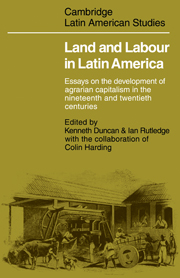 Land and Labour in Latin America
Land and Labour in Latin America Book contents
- Frontmatter
- Contents
- List of tables
- List of figures
- List of maps
- Acknowledgements
- 1 Introduction: patterns of agrarian capitalism in Latin America
- PART I THE TRANSITION FROM TRADITIONAL HACIENDA TO CAPITALIST ESTATE
- 2 Hacienda profits and tenant farming in the Mexican Bajío, 1700–1860
- 3 Landlord, labourer, and tenant in San Luis Potosí, northern Mexico, 1822–1910
- 4 Land and labour in rural Chile, 1850–1935
- 5 The development of the Chilean hacienda system, 1850–1973
- 6 Relations of production in Andean haciendas: Peru
- 7 The formation of the coffee estate in nineteenth-century Costa Rica
- PART II THE DEVELOPMENT OF A PLANTATION ECONOMY WITH LABOUR RECRUITMENT FROM HIGHLAND PEASANT COMMUNITIES
- PART III THE DEVELOPMENT OF COMMERCIAL AGRICULTURE USING EUROPEAN IMMIGRANT LABOUR
- PART IV THE TRANSITION FROM SLAVE PLANTATION TO CAPITALIST PLANTATION
- PART V POSTSCRIPT
- Glossary of Spanish and Portuguese terms used in the text
- Weights and measures
- Notes on contributors
- Indexes Subjects
- Authors
4 - Land and labour in rural Chile, 1850–1935
Published online by Cambridge University Press: 07 May 2010
- Frontmatter
- Contents
- List of tables
- List of figures
- List of maps
- Acknowledgements
- 1 Introduction: patterns of agrarian capitalism in Latin America
- PART I THE TRANSITION FROM TRADITIONAL HACIENDA TO CAPITALIST ESTATE
- 2 Hacienda profits and tenant farming in the Mexican Bajío, 1700–1860
- 3 Landlord, labourer, and tenant in San Luis Potosí, northern Mexico, 1822–1910
- 4 Land and labour in rural Chile, 1850–1935
- 5 The development of the Chilean hacienda system, 1850–1973
- 6 Relations of production in Andean haciendas: Peru
- 7 The formation of the coffee estate in nineteenth-century Costa Rica
- PART II THE DEVELOPMENT OF A PLANTATION ECONOMY WITH LABOUR RECRUITMENT FROM HIGHLAND PEASANT COMMUNITIES
- PART III THE DEVELOPMENT OF COMMERCIAL AGRICULTURE USING EUROPEAN IMMIGRANT LABOUR
- PART IV THE TRANSITION FROM SLAVE PLANTATION TO CAPITALIST PLANTATION
- PART V POSTSCRIPT
- Glossary of Spanish and Portuguese terms used in the text
- Weights and measures
- Notes on contributors
- Indexes Subjects
- Authors
Summary
The agrarian sector continues to present a baffling problem in Chile. Over the past decade, new tenure patterns and labour systems have been formed, reformed, and shattered through movements led by urban cadres – frequently armed with little more than passionately held assumptions. Despite the interest and energy recently focused on the countryside, remarkably little is known about the formation and nature of rural society. Usually illiterate, rural people wrote few memoirs or confessions; not owning land, rarely hired by contract, and usually disposed to toil without complaint (or having little hope of legal redress), they left little trace in the written records and are only dimly perceived through the eyes of travellers. Even in fairly recent times one is forced to infer the workers’ existence from the volume of their output or the nature of the demands placed on them. One way to get at the elusive subject of rural society is by examining the more statistically visible agrarian units – haciendas, medium and small farms – around which labour was organized. That is the aim of the present paper. We present first a statistical picture of changes in land distribution under the impact of expanding markets during the century up to 1935, and then we discuss the way the lower rural society adapted to the new conditions.
Although writers, with tiresome predictability, describe Chile as a ‘long thin land of contrasts’, many are inclined to generalize about the central nucleus. But even here the broken terrain and micro-climates produce a variety of geographic patterns that should be kept in mind.
- Type
- Chapter
- Information
- Land and Labour in Latin AmericaEssays on the Development of Agrarian Capitalism in the nineteenth and twentieth centuries, pp. 83 - 102Publisher: Cambridge University PressPrint publication year: 1978
